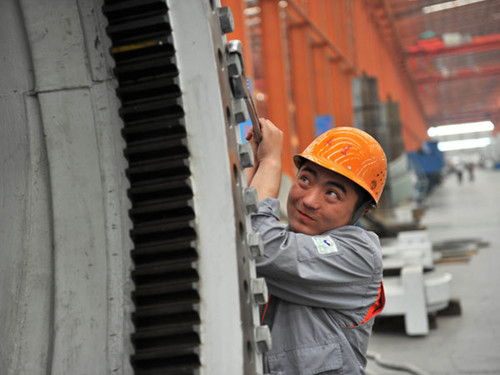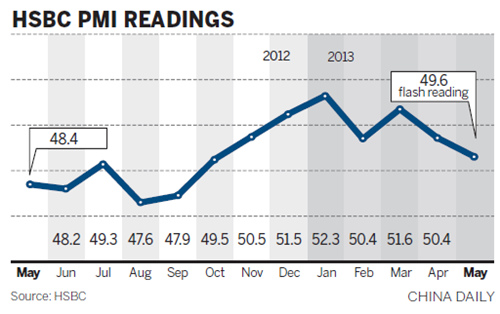
A worker tests wind power equipment in Zouping, Shandong province. Manufacturers have felt increasing pressure since last year, when GDP expanded by 7.8 percent year-on-year, the slowest pace for 13 years. CUI PENGSEN/FOR CHINA DAILY

HSBC readings show factory production may hit seven-month low in May
China's manufacturing production contracted in May to a seven-month low, suggesting its economic slowdown may deepen in the second half.
HSBC on Thursday predicted that the manufacturing Purchasing Managers' Index, or PMI, may fall to 49.6 in May from 50.4 in April, the first time it has dipped below 50 — the point that separates expansion from contraction — since October 2012.
The new orders index dropped to 49.5, the first below-50 reading in eight months. A sub-index to show output dropped to a three-month low of 51, compared with 51.1 in April, HSBC said.
This preliminary indicator, based on feedback from 420 manufacturing managers in a PMI survey, was released a week before the official figure.
Weak domestic demand and unremitting overseas headwinds may add downside pressure to the world's second-largest economy as the second quarter goes on, analysts said.
Global financial giants have successively lowered their expectations for China's 2013 GDP growth rate since May. UBS AG downgraded its forecast to 7.7 percent from 8 percent, JPMorgan to 7.8 percent after initially predicting 8.2 percent and Nomura Securities Co Ltd is now expecting 7.5 percent, down from 7.7 percent.
"A sequential slowdown is likely in the middle of the second quarter, adding downside risk to China's fragile growth recovery," said Qu Hongbin, chief economist for China at HSBC.
There is enough fiscal ammunition to boost growth but further signs of labor market slackness may need more policy support, Qu said.
Manufacturing entrepreneurs have felt increasing pressure since 2012 when year-on-year GDP expanded at a 13-year low of 7.8 percent.
Zhang Guanjin, general manager of Shaoxing Jinyong Textile Co Ltd in East China's Zhejiang province, has seen the company's export orders drop by 20 percent in May.
"Exports have been more difficult than ever since 2008. I don't think the situation will change much in the following three years," said Zhang, who has decided to produce scarves instead of raw textiles to make sure some profits come in.
Jinan Test Machine Co Ltd in Shandong province, which exports most of its products to Italy and Canada, has lowered sales prices by 20 percent to increase new orders.
"But it doesn't seem to help very much, as the market lacks robust demand both internally and abroad," said Li Jingjing, the company's export sales manager.
Zhang Zhiwei, chief China economist at Nomura Securities, predicted that China may face stronger downside headwinds in the second half, as the government falls under rising pressure to tighten policies against systemic financial risk.
Fast-expanding total social financing and persistently elevated property prices will stop the government from releasing bold stimulus packages, Zhang said.
He predicted that GDP growth might slow to 7.5 percent in the second quarter from 7.7 percent in the first three months, and continue to decelerate to 7.3 percent in the second half.
Wang Tao, chief China economist at UBS, is more optimistic than Zhang. He foresees "a smooth growth trajectory against a stable macro policy".
Wang expected a weaker rebound in the second quarter. "The government is expected to push forward structural policies and reforms that can unlock autonomous growth in the economy. In the near term, more actions are to be expected on increasing renminbi flexibility and opening capital accounts," she said.
Qu from HSBC warned that employment reduction might become a more serious concern for policymakers if the sluggish production continues in the coming year.
The May reading of an HSBC PMI sub-index shows employment retreated to 49 from 49.3 in April, a six-month low.
He Yunguang, senior consultant of the industrial division of the human resources company Kelly Services China, said the weak employment trend started as early as the second half of 2012.
The stagnant global economy combined with slower GDP growth in China is the main reason for the less robust hiring demand in the industrial sector, He said.
"Some European and US companies are going back to solve their problem of high unemployment. Meanwhile, China is losing its competitive edge to Southeast Asian countries in terms of labor cost," he added.

Copyright ©1999-2011 Chinanews.com. All rights reserved.
Reproduction in whole or in part without permission is prohibited.